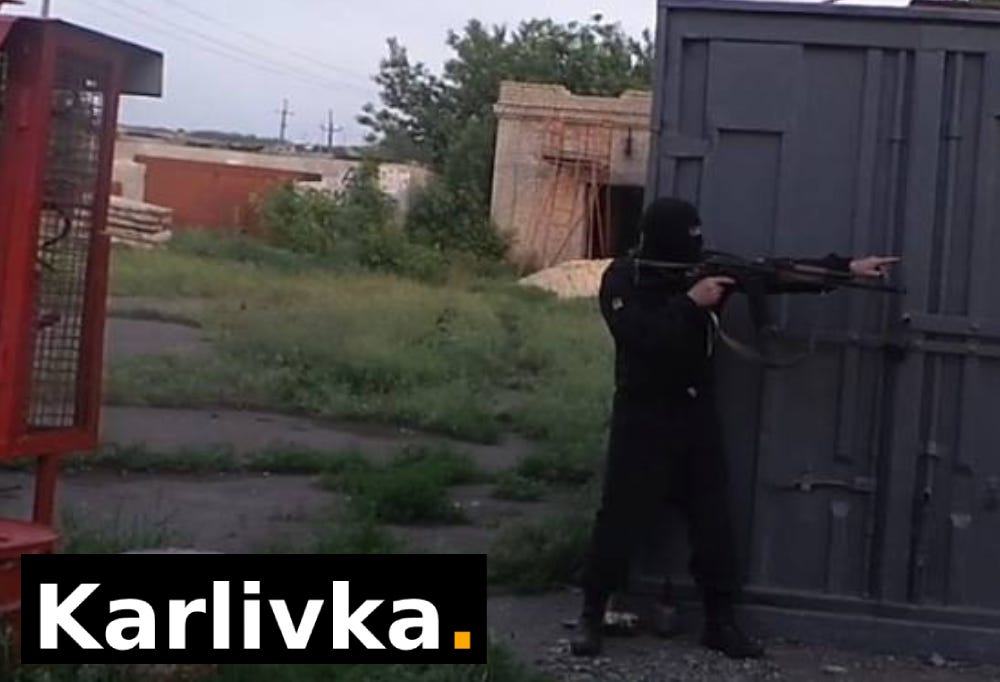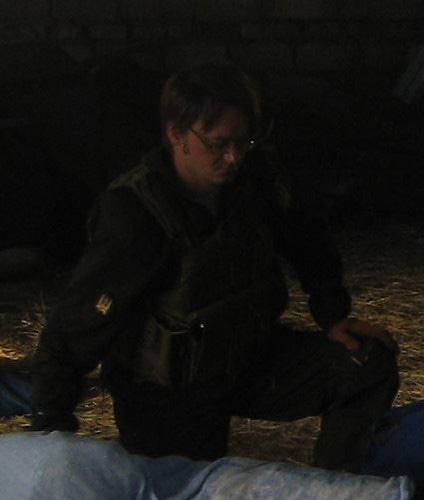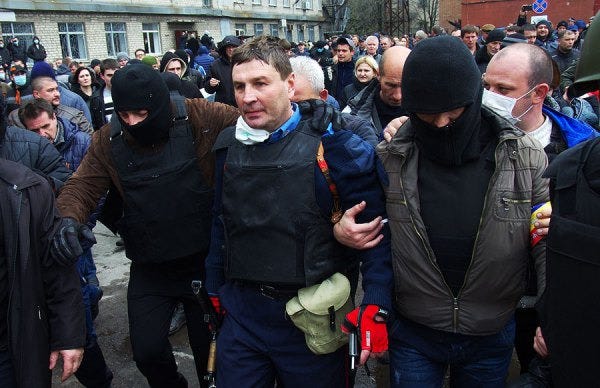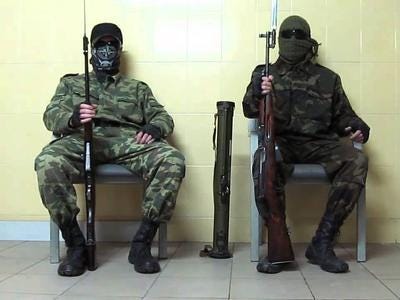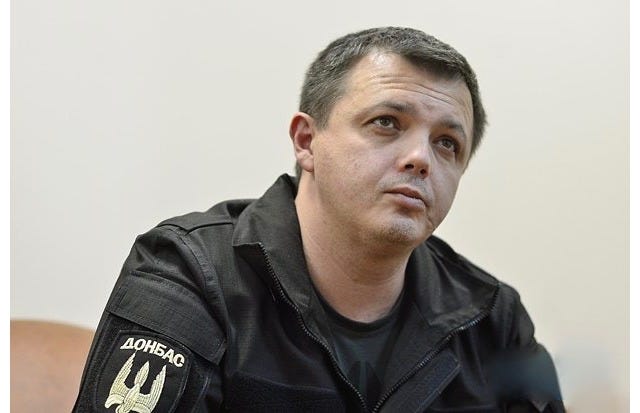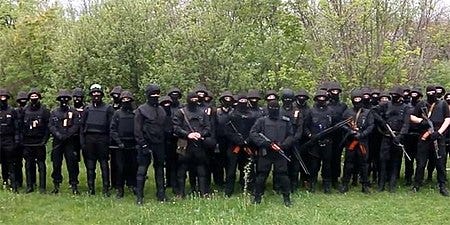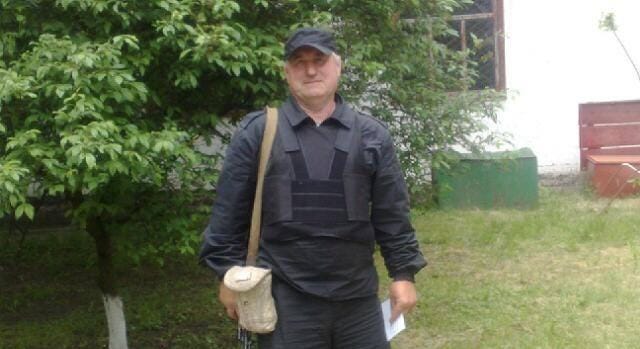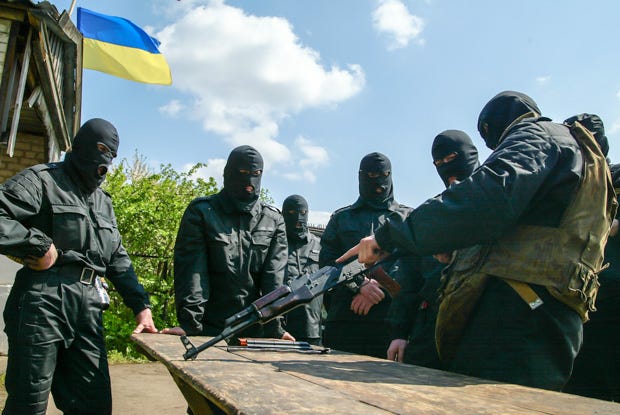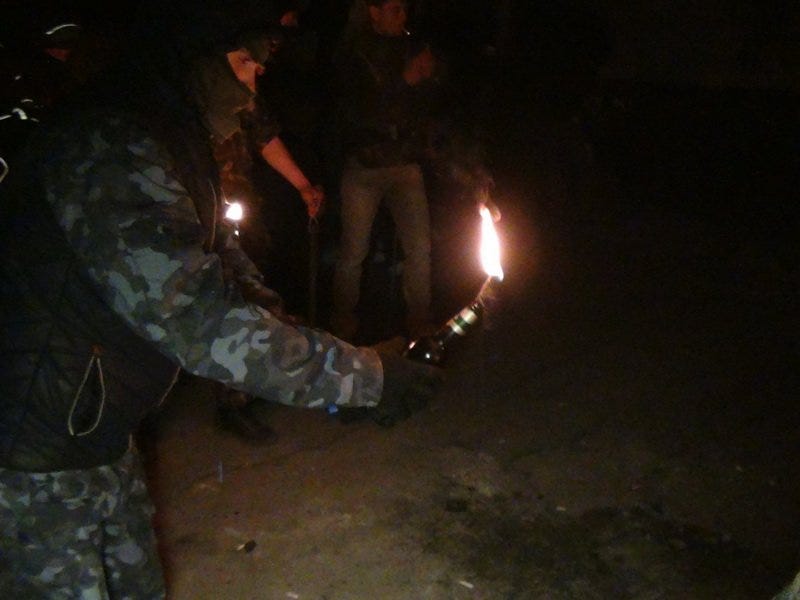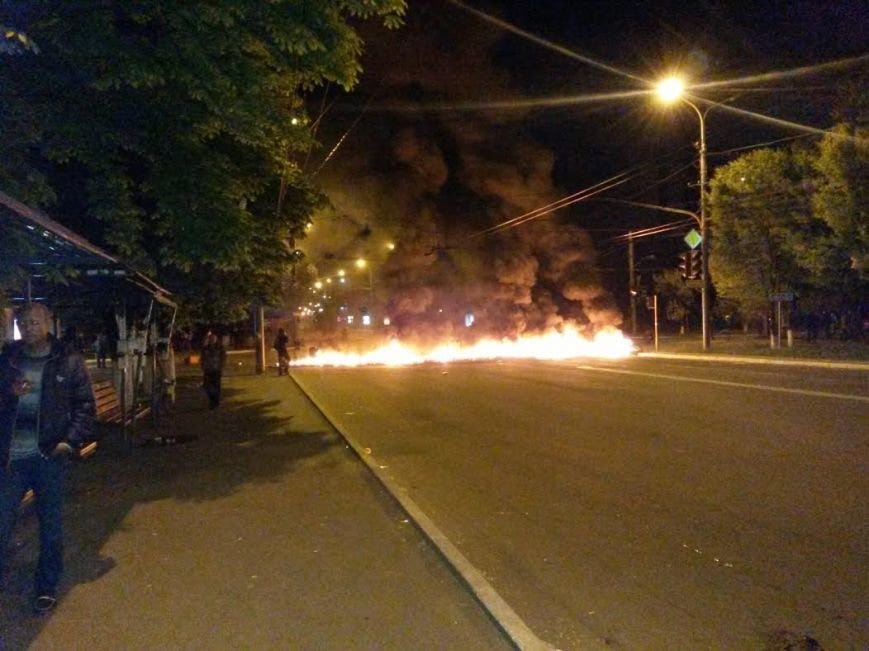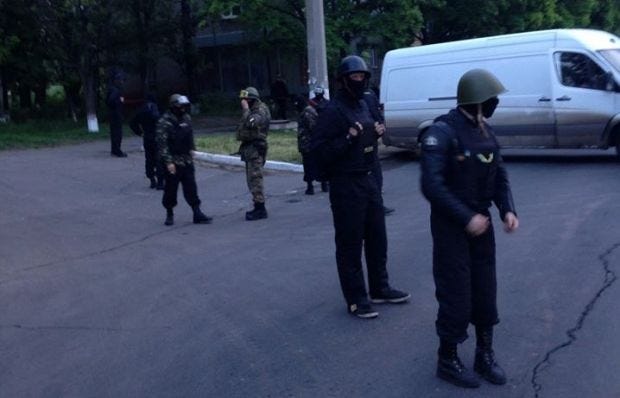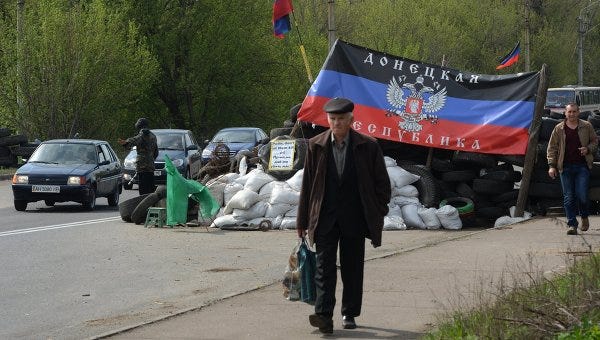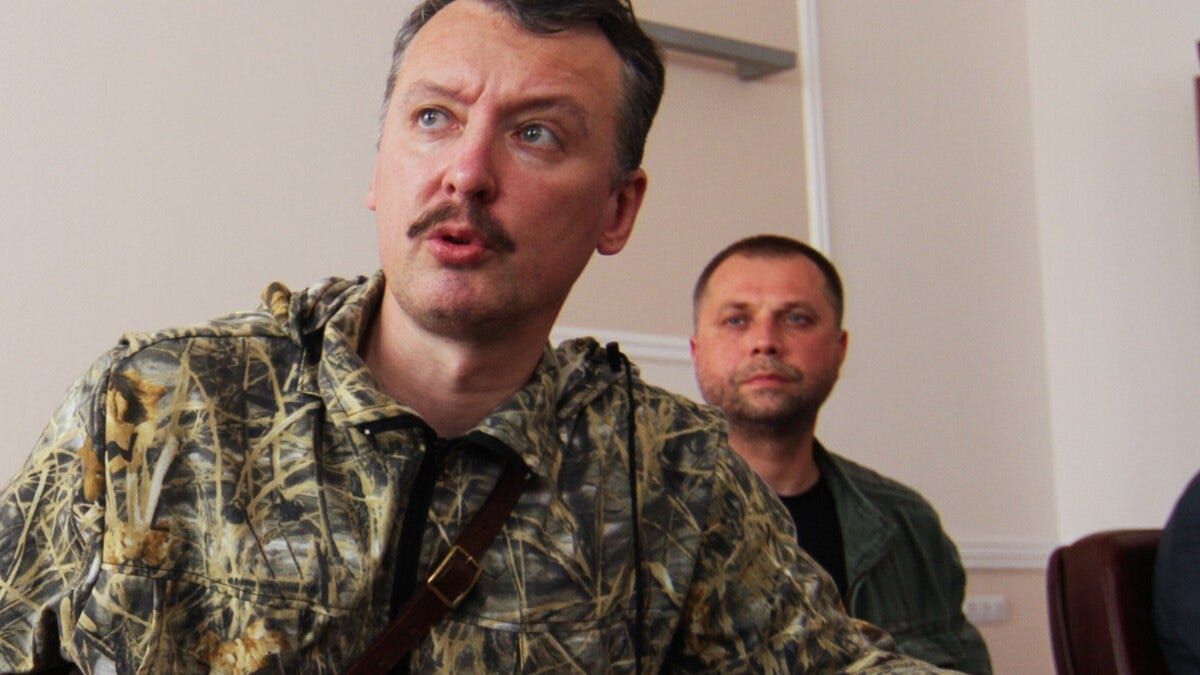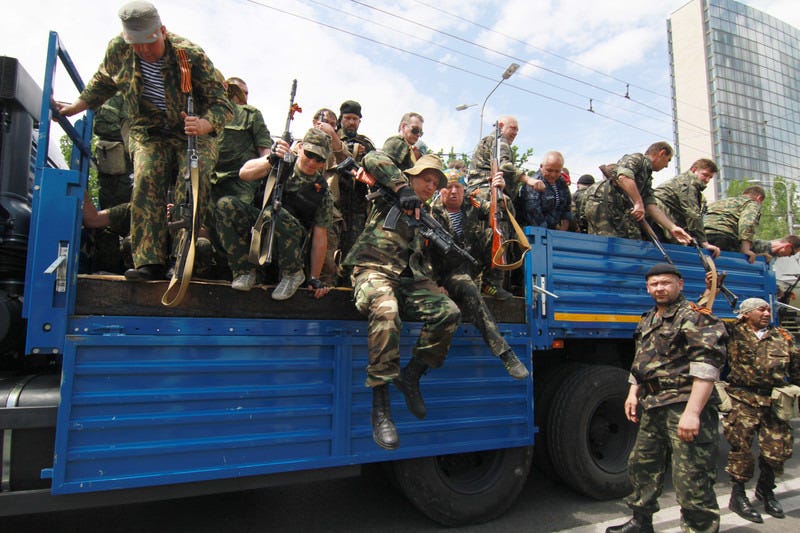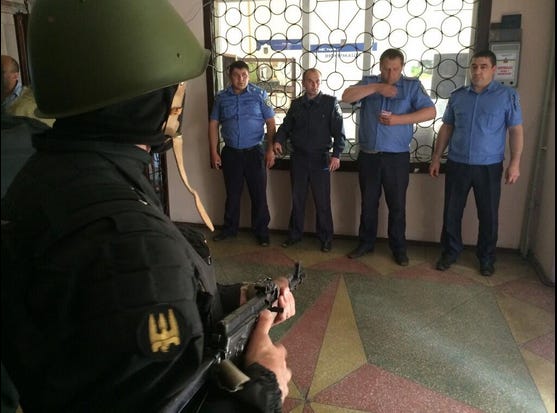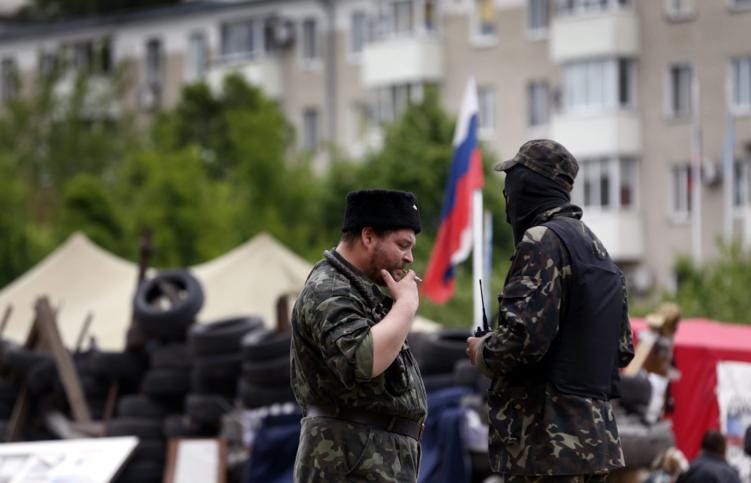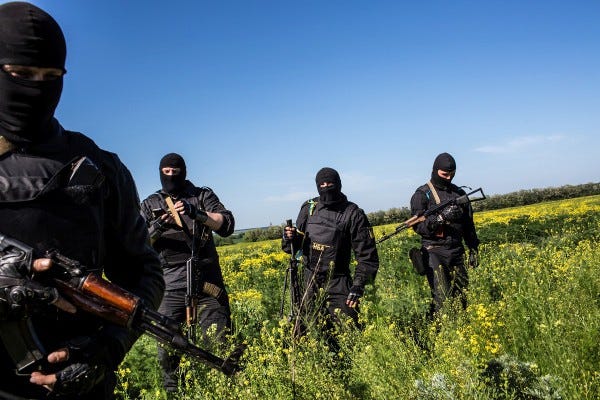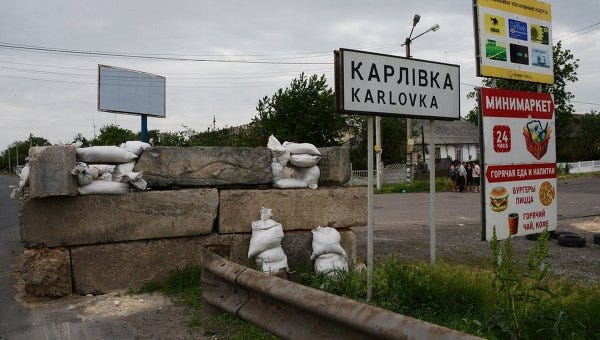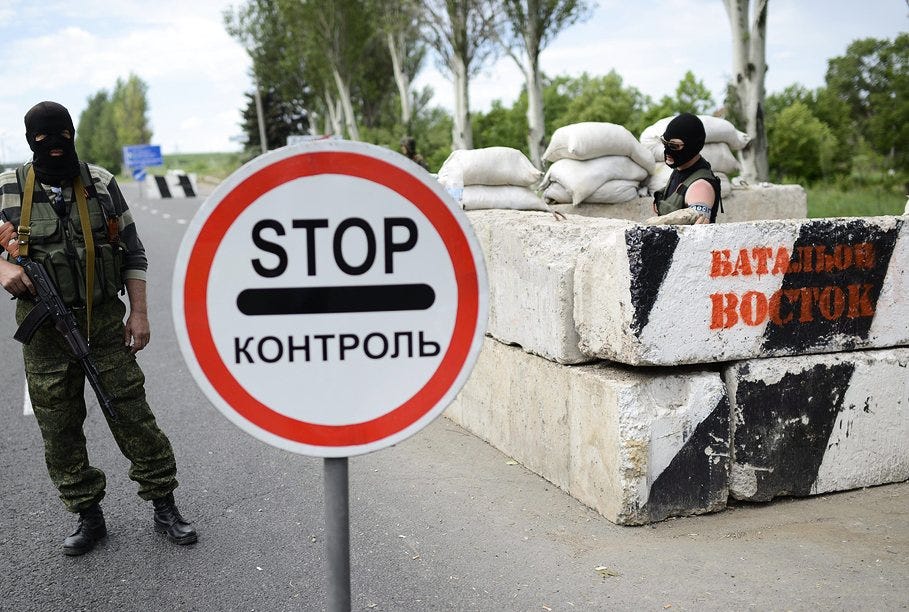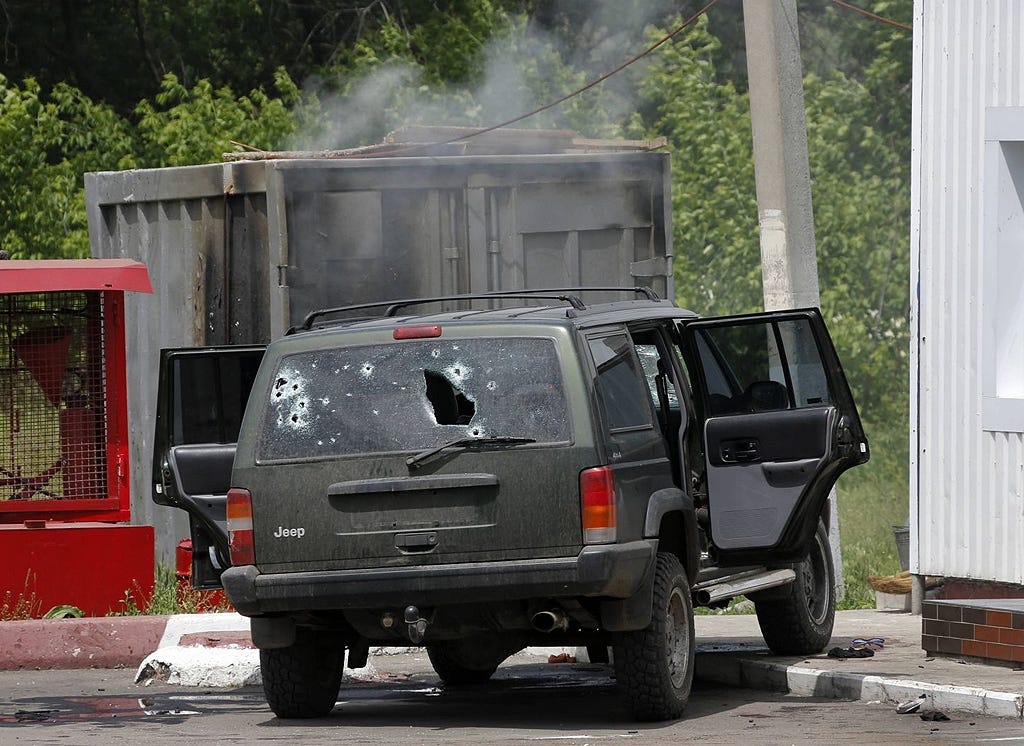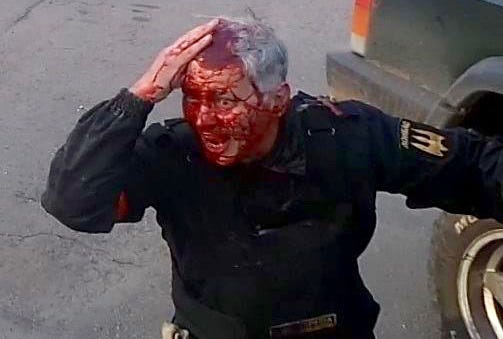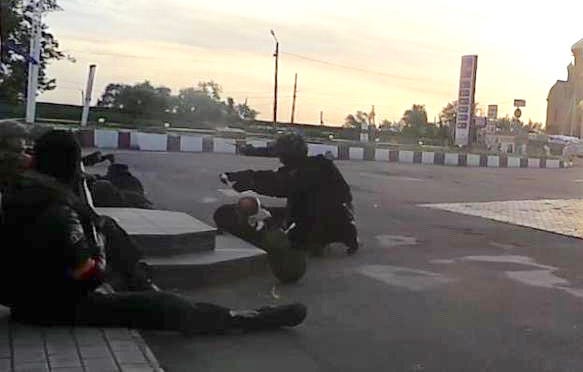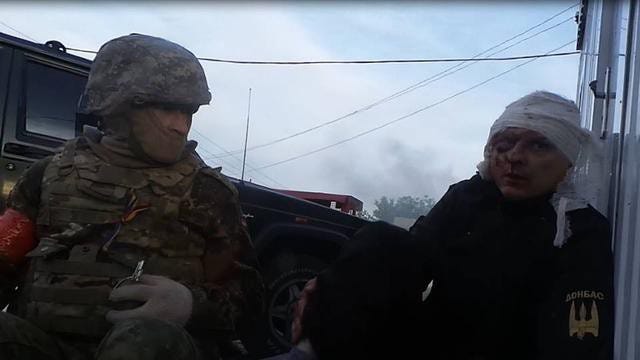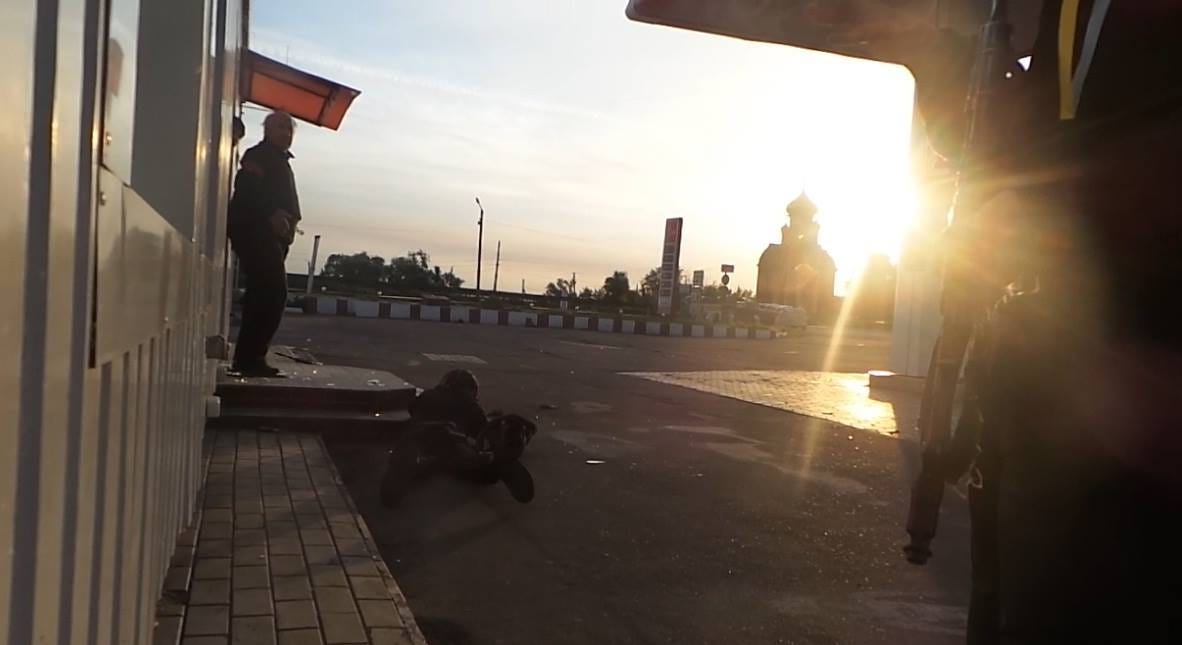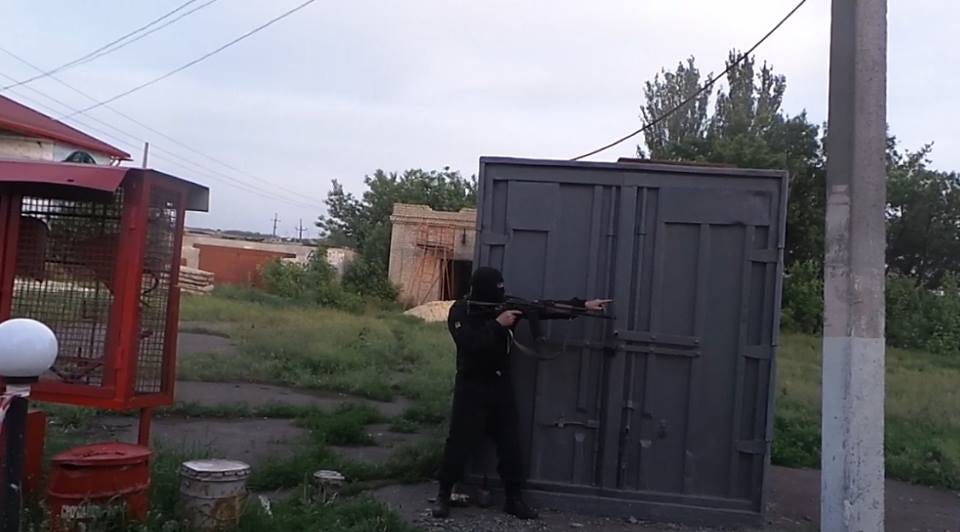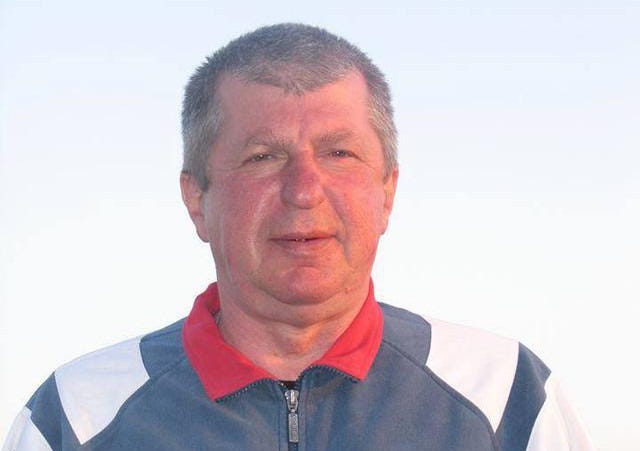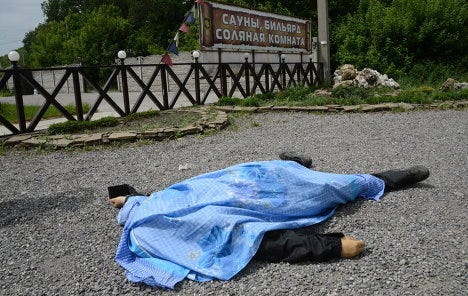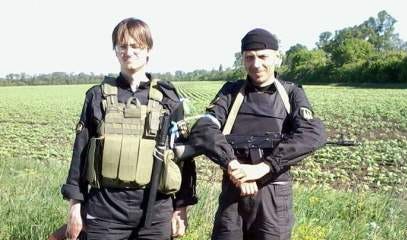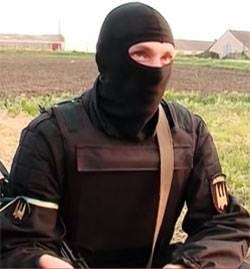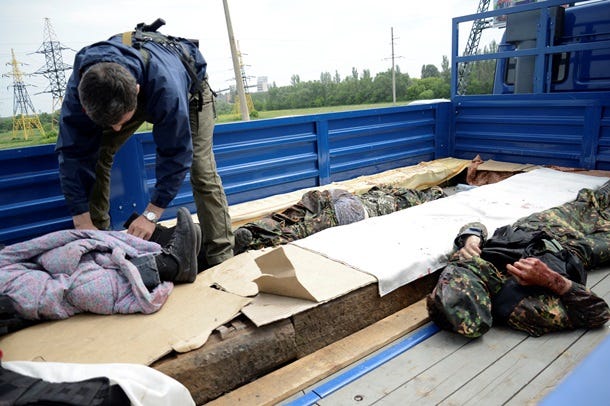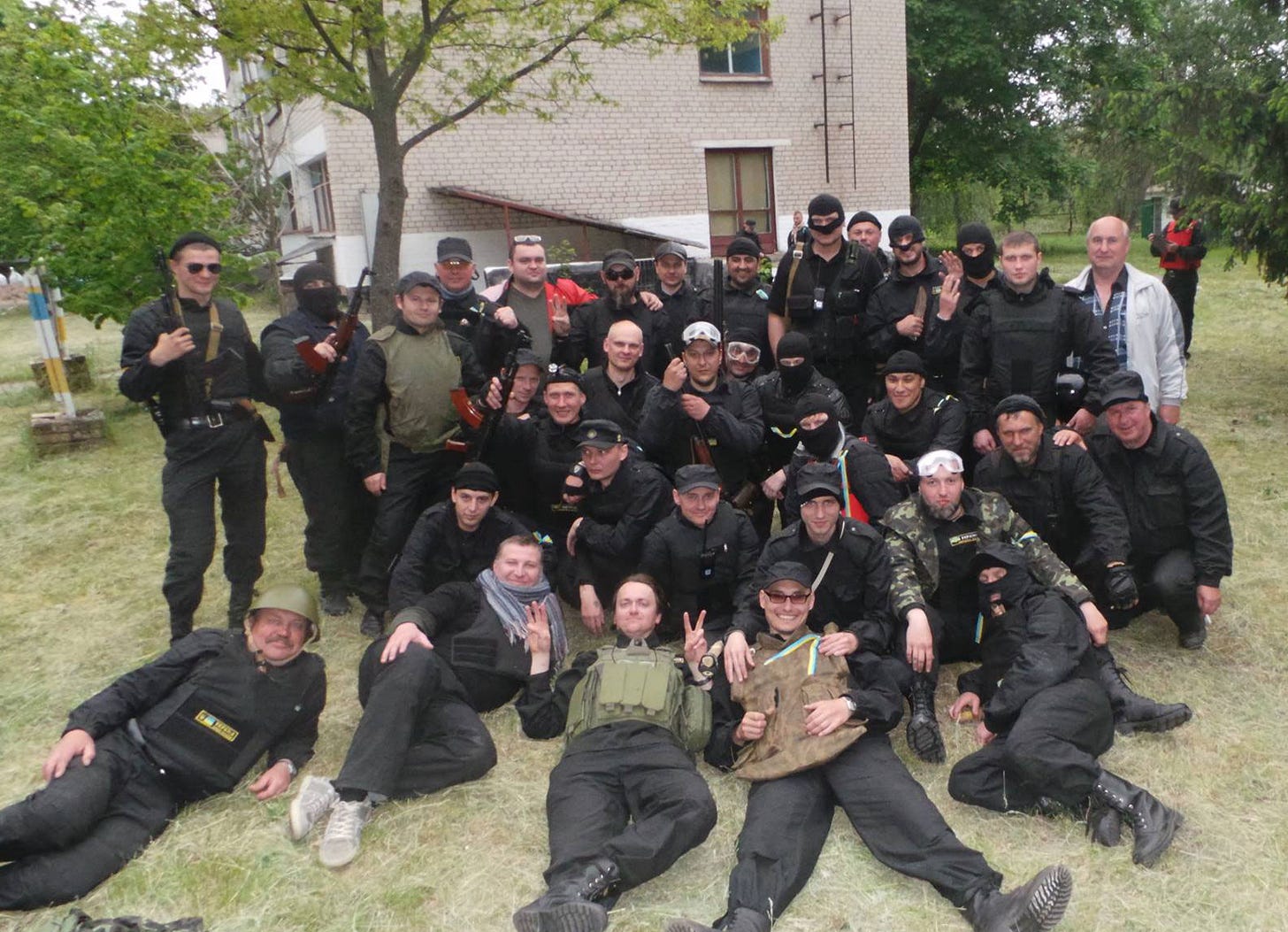The Karlivka Ambush: Donbas Resistance and Russian Mercenaries
Only 30km from Donetsk, a swiftly advancing group of Ukrainians and Russians from the Donbas met the true face of the Russian "People's Militia"
“After the battle, we couldn’t find the body of Oleh Kovalishyn, callsign ‘Raider,’ who died for Ukraine. He was in the rearguard, covering our retreat. He fought with a hunting rifle… With two fucking bullets!”
Oleh Kovalishyn was born in 1979 in the now infamous town of Bakhmut (then called Artemivsk). He would pick up an interest in programming, leaving the Donbas to study and work in Kyiv’s booming IT-sector. He was also a regular contributor to the Ukrainian Wikipedia. Oleh was fairly apolytical, wasn’t a member of any political party nor of any radical group.
So how did ‘Raider’ find himself surrounded by heavily-armed insurgents, fighting for his life against a hail of grenades and bullets?
I. Terror and Resistance
The shock occupation of Sloviansk and nearby towns by Igor Girkin’s paramilitary group on April 12th, 2014 unleashed unprecedented and coordinated political violence across the Donbas. On the 14th, a mob of 250 Russian rioters under GRU agent Igor Bezler, armed with melee weapons and molotov cocktails, stormed the Interior Ministry HQ in Horlivka, nearly lynching multiple policemen. The station’s chief was arrested by Bezler’s militiamen, who soon moved to target the rest of the city’s government buildings as well as a pro-Ukrainian outlet’s office.
This was part of a pre-planned effort across the two Oblasts. Police buildings would be the first targets in order to acquire firearms, and a violent takeover of the rest of a city would follow. Political opponents - Maidan activists, pro-Ukrainian journalists and politicians - would be kidnapped, tortured, and as in the case of Horlivka city councillor Volodymyr Rybak, killed.
Violence would not be limited to political opponents. In Sloviansk, Girkin’s militants repeatedly targeted the city’s Roma population in pogroms to the extent that it seriously escalated the ongoing refugee crisis: “According to the Roma, unknown armed men would break down their doors, loot their belongings, and beat even women and children.”
Another group under attack from the militants were business owners, large and small. In Donetsk, looting and seizure of property was becoming rampant. On April 22nd, activists in Donetsk protested in support of a local business owner who refused the militants’ demands to take down a Ukrainian flag from his property. The militants threatened to burn down his business. The businessman, Oleksandr Klimenko, stated that “the separatists take over public property with quiet acquiescence or even support from the local government. Now, they’re moving onto private property, onto business.”
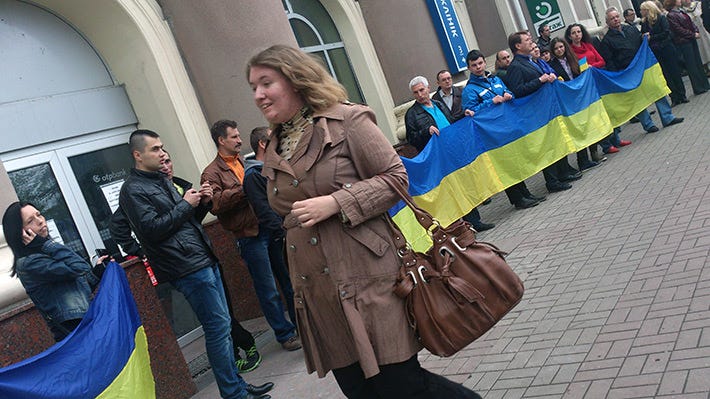
As all this was going on, the confused inaction of local police gave way to full paralysis. Meanwhile, Kyiv’s forces in the Anti-Terrorist Operation still numbered no more than a thousand people, most of them preoccupied in the hotspot around Sloviansk. Demoralized National Guard detachments were besieged in their bases by pro-Russian civilians and militants, while the army was still in the process of mobilizing the reservists and organizing something resembling a coherent force. On April 27th, Interior Minister Arsen Avakov declared that the law enforcement in the Donbas is ”functionally unready to fulfill its duties.” The message was clear: civilians in Donetsk and Luhansk Oblasts were on their own.
On the very next day, Russian rioters, militants, and allied criminal elements violently suppressed a pro-Ukrainian protest in Donetsk. Such protests were a regular occurence in the city since March and were targeted from the very start: on March 14th, a Russian mob walked through a hole in the police line and attacked the protestors, stabbing one to death. And yet even with that in mind, the scale and organization of violence upon the protestors on April 28th was unprecedented. At least 15 protestors were seriously injured, while 5 "disappeared without a trace." This was the last protest of its kind.
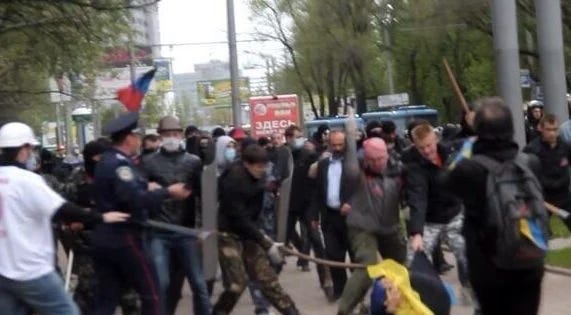
Meanwhile in Sviatohirsk, a town in the north-west of Donetsk Oblast located right next to Sloviansk, a local small business owner going by “Lesnik” - forester - organized a self-defence militia. They weren’t the first - previously, small groups supported by local authorities would come together and erect checkpoints in Zaporizhzhia and Dnipropetrovsk Oblasts to prevent a spillover of violence. However, Lesnik’s group was so far the largest to operate within territory where Ukrainian authorities had zero presence. Accordingly, first mentions of the militia in the news would come as the militiamen skirmished against Girkin’s scouts in the woods north of Sloviansk on April 24th. In Sviatohirsk, Lesnik’s second in command, former policeman Serhii ‘Did’ Primaichuk, would prevent a takeover of the town hall by the militants. Primaichuk recounted meeting the militants, carrying a rifle wrapped in a blanket:
“Once the bus arrived I came out to greet them, with my guys staying hidden nearby. I asked them: “What is the purpose of your visit? Tourism? With bats and these St. George’s ribbons [a pro-Russian symbol]?” I warned them: “should even one of you step out of that bus…” and flashed my rifle. They spent the next two hours thinking, whether to come out of the bus with all their [Russian] flags or not. In the end, I gestured to the bus driver and told him: if you don’t want to end up carrying your bus away on your back, then drive off or you’ll have problems. I flashed my rifle again. And just like that, they left.”
II. Little Black Men
In early April, another local businessman and civic activist Kostiantyn Hrishyn (soon to become one of the early war’s most controversial figures) contacted the Donetsk Oblast Administration. He proposed to cooperate in creation of a special volunteer unit that would aid the beleaguered police. As the Administration still thought they could use the growing pro-Russian unrest to extract concessions from Kyiv, they refused. When the situation eventually spun out of control, it was too late. Hrishyn adopted a nom-de-guerre, “Semen Semenchenko,” and under this alias began recruitment himself, on Facebook. In mid-April, first mentions of the “Donbas” Battalion began to appear in Ukrainian media.
The promotion campaign on social media went exceedingly well, and the fledgling group was almost immediately picked up by the legendary Jewish-Ukrainian oligarch Ihor Kolomoiskyi. Kolomoiskyi was at the time head of the Dnipropetrovsk Oblast Administration, and he was very keen to avoid the spread of disorder into his territory: by mid-April Dnipropetrovsk Oblast became a mustering ground for volunteer groups like “Donbas” and the Ukrainian Volunteer Corps (armed wing of Right Sector), various MVS units like “Dnipro-1” and the future “Azov,” as well as many of the army’s conscripts. The legality of formations like Donbas and Right Sector was dubious to say the least, so the Oblast Administration could not provide them with arms. Aid to “Donbas” in general was limited to a lodging area on an abandoned tractor plant, food, and the black police-grade uniforms that the Battalion would soon become famous for. As one fighter described:
“Thanks to the successful social media campaign by the battalion commander, we began receiving crowdfunded aid from supportive Ukrainian citizens. With this money we bought uniforms, first bulletproof vests, loadouts and food. We also acquired several models of AK-74 rifles - they couldn’t shoot, but would be useful during operations as a tool of intimidation.”
Them and the other volunteer units would be nicknamed the “Little Black Men” in an allusion to Russia’s “Little Green Men.”
On April 17th, the first batch of volunteers began gathering in front of the Dnipro Oblast Administration building to be taken to the Battalion’s base at the aforementioned abandoned tractor plant.
The volunteers were overwhelmingly Russian speakers from the Donbas. One of these volunteers, callsign “Felix” recounted:
“When I saw what was happening to my Donetsk, when all those “cossacks” came here, all those quasi-fascist elements, when they started marching around, when they ripped apart a “Shakhtar” [Donetsk football club] flag shouting that it’s Banderite… These people weren’t locals. I left for Dnipro on April 18th, already a part of the second group of volunteers. […] We divided ourselves into seperate groups, seperate companies. Organized an internal service, organized security around our base. We were trying to increase our abilities. Bying uniforms, doing basic training. Many of the guys haven’t served in the army before, so we bought [AK] models, trained in assembling and disassembling them.”
Another volunteer, callsign “Filaret,” added:
“I remember seeing an ad on the internet, that the “Dnipro” volunteer battalion was recruiting. At 11:00 I saw the ad, and by 13:00 I was already on a train bound for Dnipropetrovsk. I am originally from Luhansk. Guys from “Dnipro” met me and immediately told me: “there’s actually a “Donbas” battalion gathering here as well, that’s where you are from after all.” So that’s how I got into “Donbas.” Initially we were 15 guys, then 30, 50 […] At the start we had no weapons. We had wooden sticks, clubs. Some hunting rifles. A “Degtyarev” machinegun from the Great Patriotic War, though it could only fire single shots. It was dug up from somewhere.”
Another common thread between the volunteers is that many identified as ethnically Russian, and all became radicalized Ukrainian patriots during the events of the Euromaidan and the Revolution. Nikolai Kozlov, a 61 year old from Siberia who moved to Donbas to work as a miner, would become the battalion’s Chief of Staff and train the other volunteers, as he used to be a Major in the late Soviet Border Guard. He volunteered to join after his son was mobilized in late March, as he could not sit idly by while his son was at war.
“During the Euromaidan, dad was trying to figure out what’s really happening. This is when my parents started watching the Ukrainian channels and not only Russian ones. […] Dad drove to Kyiv. He drove around to evade the police blockade. In Kyiv he walked to the Maidan on foot from the outskirts of the city. […] He got there right as blood was being shed. Dad couldn’t believe that right in the heart of the capital of a modern European country people are being shot as if they’re hunted animals.
Dad returned very shaken. He kept talking about the depths of cynicism that the government sank to. What he saw there was a revelation for him. He repeatedly told us this story: “A boy with two bullet wounds is being carried away on a wooden shield - he was so small that he fit on that shield which he tried to hide behind. Blood is streaming out of him, yet he’s singing the Ukrainian anthem”
Kozlov took the callsign “Matvei” - the name of his grandfather who died in the Great Patriotic War.
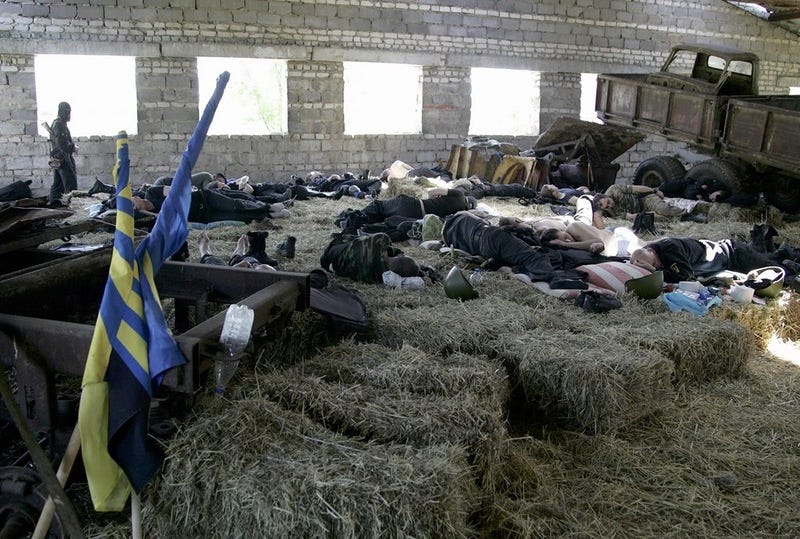
On April 28th, as pro-Ukrainian protestors were being beaten in Donetsk, Hrishyn would publish a statement on his Facebook page. In it he called on Arsen Avakov to provide them with weapons, or otherwise they would take up arms by themselves and act “as the situation requires”
“The situation with inactivity of the majority of MVS personnel in Donetsk Oblast keeps getting worse. [The Russians] are let into administrative buildings, their leaders make voyages to the “blockaded” Sloviansk, […] policemen who couldn’t care less about the kidnapping of Horlivka councilman Volodymyr Rybak that happened right under their noses, killings and beatings of protesters, kidnappings of journalists, of SBU personnel, of Armed Forces of Ukraine’s servicemen, of the commander of Luhansk battalion of the National Guard for god’s sake, its all a signal that the disease has progressed to the level where therapeutic methods don’t cut it anymore.
We, volunteers of the Donetsk Oblast defence battalion, are trying to get permission for weapons — yet we’re denied, the registered weapons that some members have aren’t enough […] we catch people planning to kidnap foreign journalists, with photo and video evidence, a man who has been to prison more than once, who has been detained several times by the SBU earlier, and he’s just let go after a few hours.
Does the MVS realise that it’s playing with fire in the East, that the situation is rolling towards civil war? We’ll just have to take up arms by ourselves, to start practicing kidnappings to exchange these bastards for our patriots, and to the policemen who are in bed with and actively assist the terrorists we will react just as the situation will require us to.”
These would not be empty threats.
III. “Illegal Armed Formations”
“Our first operations would be attacks on the separatist checkpoints near Krasnoarmeisk [modern-day Pokrovsk]. They were successful. We’d arrive, trash the whole place, take prisoners, bring them here to the basement, and teach them the Ukrainian anthem”
— callsign “Filaret”
“Nonetheless, the volunteers weren’t sitting around waiting for Kyiv to recognise them, make them a legal organization, give them weapons - in practice, the patriots started acting like a true illegal armed formation [Ukrainian term for an illegal militia, same classification as the Russian paramilitaries]
— Evhen Shevchenko, “Donbas” veteran
The Battalion’s first operation was an attack on a Russian checkpoint near Pokrovsk, then named Krasnoarmeisk, on May 1st. By then such checkpoints were littered all across the Donbas, usually manned by small groups of pro-Russian locals with a limited amount of weapons and zero training, discipline, or organized leadership. This the Battalion would use this to it’s advantage: this first attack saw them utilize the element of surprise to its fullest extent, driving up to the checkpoint, disembarking en masse, throwing the militants to the ground and arresting them. One of the Battalion’s members recorded this attack on his phone:
The attack appears to have been led by Kozlov, the 61 year old Chief of Staff, as a man with his body build and gait can be seen issuing orders to the rest of the group. This raid netted the Battalion 15 prisoners and more importantly, 3 AK assault rifles. This may seem like a small bounty, but for a group that just fought with sticks and fists this was a breakthrough. Overall, it was an overwhelming success. But curiously enough, the Battalion initially denied responsibility for this attack, and in an MVS statement those behind it are called “unknown patriots.” Additionally, it says the prisoners were handed over to police. This could indicate some sort of coordination already ongoing between MVS and the “Donbas.” The question of the Battalion’s relationship to the MVS at this early stage is further raised by the events in Mariupol.
Donetsk Oblast’s second largest city is one of the few where the Ukrainian state put up a fight. On April 15th, commander of Military Base 3057, housing Mariupol’s 17th Seperate Battalion of the National Guard, was approached by ringleaders of a group of Russian militants demanding he take the “side of the people” and hand over the base’s weapons. This would’ve turned Mariupol into a second Sloviansk, and could’ve spelled an early doom to the ATO. Col. Sovinskyi refused. The next evening, a group of several hundred rioters in balaklavas and camouflage suits, mixed in with pro-Russian civilians, attempted to break into the base. After warning shots had no effect, Sovinskyi’s men opened fire into the crowd. At least a dozen were injured, and clashes continued into the next day, when Avakov announced nearly a hundred attackers had been arrested.
Aferwards, it took the militants some time to regroup. The rest of April only saw small-scale clashes concentrated around administrative buildings, which changed hands almost daily. By the start of May, the situation escalated again: on the 3rd, smoke from burning tires engulfed the city center.
“They’re starting to light the tires around the City Hall on fire. Shots can be heard all around. Sirens from Ambulance and Civil Defense vehicles are howling. Tracer bullets are starting to fly around the City Executive Council.”
The self-proclaimed “People’s Governor” of Donetsk Oblast Pavel Gubarev posted a call to action on his Facebook page:
The Junta is preparing to clear out the City Hall building. National Guard soldiers and heavy vehicles are in town. Mounted on several BTRs, the National Guard approaches the City Hall. Mariupol, rise up!
The MVS quickly lost what control it still held over the situation. The city’s National Guardsmen and high-ranking policemen began to be kidnapped. Soon, the “little black men” began to appear on city streets. To assist the local police and the National Guard, Avakov called in the handful of fighters from the two newly-created volunteer battalions subordinated to the MVS: “Dnipro-1” and “Azov.” The detachments numbered around a dozen fighters each. But curiously enough, the illegal “Donbas” battalion sent a detachment of its own as well.
For participation in this operation, the “Donbas” battalion (despite lacking any legal status) was handed a dozen rifles, ammunition, and grenades on the orders of one of the National Guard commanders. The weapons were given to us with one requirement: that we return them after completion of the tasks at hand. The tasks were completed, but of course nobody was going to give back such priceless weapons, ammo and grenades, so the “Donbasites” quickly left Mariupol and prepared for their next operation.
-Yevhen Shevchenko
The battalion’s two first operations both highlight an issue that the ringleaders of Russian militant formations in Donetsk faced: despite technically controlling most of the Oblast, it had no real armed force neither to expand its control nor defend what it gained. The largest coherent armed group was Igor Girkin’s paramilitary, but it was holed up around Sloviansk and engaged in heavy fighting with the bulk of the Ukrainian forces. Most of the “Republic’s” territorial control was represented on the ground by the checkpoints like the one that “Donbas” fighters dismantled - manned by local opportunists, only armed with what they could get from police stations, and most importantly - without cohesion, leadership, or willingness to actually fight. The issue was compounded by the fact that the DPR had no clear leadership itself. The “People’s Governor,” Pavel Gubarev, was under arrest since March and his authority over his “Donbas People’s Militia” was partitioned between various local leaders.
These were the problems that Aleksandr Borodai faced as he became the Republic’s first “Prime Minister” on May 16th. Borodai was a businessman and ideologue from Moscow, a close associate of Igor Girkin and their mutual benefactor, the “Orthodox oligarch” Konstantin Malofeev. It is unclear by what mechanism the appointments of May 16th occured, and Borodai was deeply involved in the events in Donbas before that: in April, the SBU intercepted a call between him and Girkin, where Borodai promised to send reinforcements and more heavy weaponry from Luhansk. It is safe to say that Borodai’s authority rested entirely on the FSB-affiliated Malofeev network and not local support. In person, Borodai was described as arrogant and with a chauvinistic attitude to the locals.
Borodai urgently needed an instrument to impose his authority on the chaotic Donetsk and exercise real control over the territory he nominally controlled. Luckily enough, he was in contact with a man working on just that: Alexander Khodakovsky. He was formerly head of the Donetsk detachment of SBU’s elite “Alpha” anti-terrorist unit. During the events of April, Khodakovsky defected along with most of his staff. By early May, Khodakovskyi commanded a formation called “Vostok” [Russian word for “East”], the first one to be explicitly subordinated to Borodai’s government. Its’ core was composed of defectors from “Alpha” as well as former members of the disgraced and disbanded “Berkut” riot police unit. “Vostok” was also actively recruiting and training both Ukrainian and Russian citizens. The “Vostok” served first and foremost as Borodai’s Praetorian Guard. As Khodakovsky himself explained in 2016:
“That Borodai, when he got here, was in all aspects a guest of mine. He lived in my flat, drove in transport which I sent to him, and used almost exclusively our abilities and communication channels until his departure in August”
Initially, “Vostok” had a colorful roster of fighters. For example there was a unit of Ossetians, which eventually became the “South” Company.
The official date of “Vostok’s” creation is May 9th 2014, when for the first time trucks full of heavily armed militants with the Battalion’s insignia appeared on the streets of Donetsk. The militants already numbered in hundreds and were armed with countless assault rifles, machineguns and grenade launchers. “Vostok” quickly became renowned for it’s volunteers from the Caucasus, and was often confused with an old Chechen formation of the same name. The Battalion’s fighters were often described as mercenaries.
In the meantime, “Donbas” prepared to expand the scope of its operations. It was granted a new headquarters near the town of Velykomykhailivka, on the border of Dnipro and Donetsk Oblasts. Raids into the separatist-held areas became somewhat frequent. The Battalion now prepared for its most ambitious operation yet: in early May, the town of Velyka Novosilka went under DPR control, with the police being complicit in its inaction as the Ukrainian flag was taken down from their station. The Battalion, numbering around 60 fighters with an arsenal of some 13 assault rifles, decided to act. On May 15th they stormed the town’s central police station and disarmed the policemen. The head of the town’s police fled in an unknown direction. Kostiantyn Hrishyn, the Battalion’s media-savvy leader, allowed a VICE News crew to accompany and record the action and widely publicised these actions on his Facebook page:
“Velykonovosilsky District of the Donetsk Oblast has been secured by the people’s militia and the “Donbas” Battalion. According to our reconnaisance, the so-called “Vostok” Battalion has been sent out by the separatists to confront us. We eagerly await the arrival of these gopniks. None of them will enter the town”
In truth, “Vostok” remained in Donetsk, largely still preoccupied with imposing Borodai’s control. More than that, a military base - the headquarters of NGU’s Eastern command - remained in the heart of the city, housing several hundred National Guardsmen. Though the base had been besieged since April, their very presence undermined the illusion of DPR’s territorial control. And despite being thoroughly demotivated, these Guardsmen could be used in the future should the ATO switch its focus to Donetsk. And so, on May 16th, “Vostok” attacked the base, meeting limited resistance. The National Guard declared that “for some time, the servicemen resisted and fired back at the attackers. At the moment, the shooting has been temporarily stopped and negotiations are ongoing.” By the day’s end, the MVS declared that the Guardsmen were allowed to leave the city. Just as “Donbas” had it’s first real operation end in success, so did “Vostok.”
IV. Karlivka
The undisputed success of these first actions, which in addition came with neither killed nor injured, as well as the possession of 13 real assault rifles, notably boosted the patriots’ morale, while the wish to free their homeland from the “Russian plague” warmed them up, this call to action becoming their entire reality! Having not met any heavy resistance the boys came to believe in their unstoppable strength and success just as much as in the weakness of their enemy. Unfortunately, both the former and the latter proved to be a fallacy. And the next, fourth, operation of the “Donbas” Battalion, which turned out to be the first firefight and the first tragedy for the volunteers, cooled everyone’s heads and was a clear signal that a real war began.
- Yevhen Shevchenko
By mid-May, elements of the 93rd Mechanized Brigade and National Guard slowly advanced along the E50 highway in the direction of Donetsk. Their behavior, however, was extremely passive. At this point the Brigade’s staff was still fresh from the chaos of mobilization, lacking equipment as basic as bulletproof vests. They relied on the motivated local forces and volunteer formations like “Right Sector” and “Donbas” to dismantle separatist checkpoints, to which the government forces would then advance.
Karlivka is a village located only 30km away from Donetsk. Sitting below a reservoir, its’ dam-bridge provided one of the few crossing points in the direction of Donetsk.
“By then a Battalion Tactical Group of the 93rd Brigade was heading in the direction of Donetsk. However, the strategically important Karlivka remained under enemy control. And thats with the fact that there, 28km away from Donetsk, on the Dnipropetrovsk-Donetsk highway, was the only bridge that could handle heavy military vehicles. There was a DPR checkpoint there since the first days of the conflict.”
- Mykhailo Zhyrokhov
“The thing is, at that moment the only bridge which could handle heavy machinery was located at the dam in Karlivka - all other major bridges were destroyed by the terrorists.”
- Yevhen Shevchenko
The previously formidable separatist garrison largely departed back to Donetsk, leaving only around a dozen fighters. The 61 year old Battalion Chief of Staff, Nikolai “Matvei” Kozlov, was set to lead an assault group of around 20 fighters. On May 22nd, the day before the planned attack, “Donbas” commander Kostiantyn Hrishyn reported on the Battalion’s advances and plans on their social media page:
“Volodarskyi District of Donetsk Oblast. A detachment from the “Donbas” volunteer battalion took the administrative buildings under guard, the DPR flag was taken down from the District Council building and the Ukrainian flag was installed in its place. […] The Western Donetsk Oblast is under control of the Ukrainian government and the “Donbas” Battalion. Now is the time for Donetsk”
On the evening before the attack, the Battalion carried out reconnaisance on the checkpoint. At one point, a dark-green jeep with 5 “Donbas” fighters slowly drove past the militants. For some reason, they weren’t stopped. What they reported back was concerning: instead of tire barricades, the checkpoint consisted of concrete blocks, sandbags, and foxholes. Instead of wooden clubs, each militant held an assault rifle.
Two fighters, “Fiedor” and the group’s sniper “Khimik” laid in the grass near the checkpoint for almost two days, studying the garrison’s schedule and shifts. With their information, a relatively simple plan was developed: during the night, only 5 militants remained at the checkpoint. Shortly before sunrise, the main 12-man assault group would attack the checkpoint head-on, while another group would take positions further along the road to prevent enemy reinforcements and civilians from driving into the combat zone. A group of some 8 fighters would stay further back from the fighting, to act as reserve. According to Shevchenko, Hrishyn himself was in this group. As in previous operations, the plan rested on the element of surprise.
And that was the plan’s main fault point. It is not clear what alerted the Russians to the upcoming raid, but the most common-held opinion is that it was the brazen actions of the recon group. Policemen from the checkpoints that the group passed on their way to Karlivka are also accused of selling the group out. Whatever the case may be, once Khodakovsky was alerted to the situation, he immediately sent out reinforcements. One group arrived during the night and laid low, while a Kamaz truck with some 80 “Vostok” militants left Donetsk in the early morning hours.
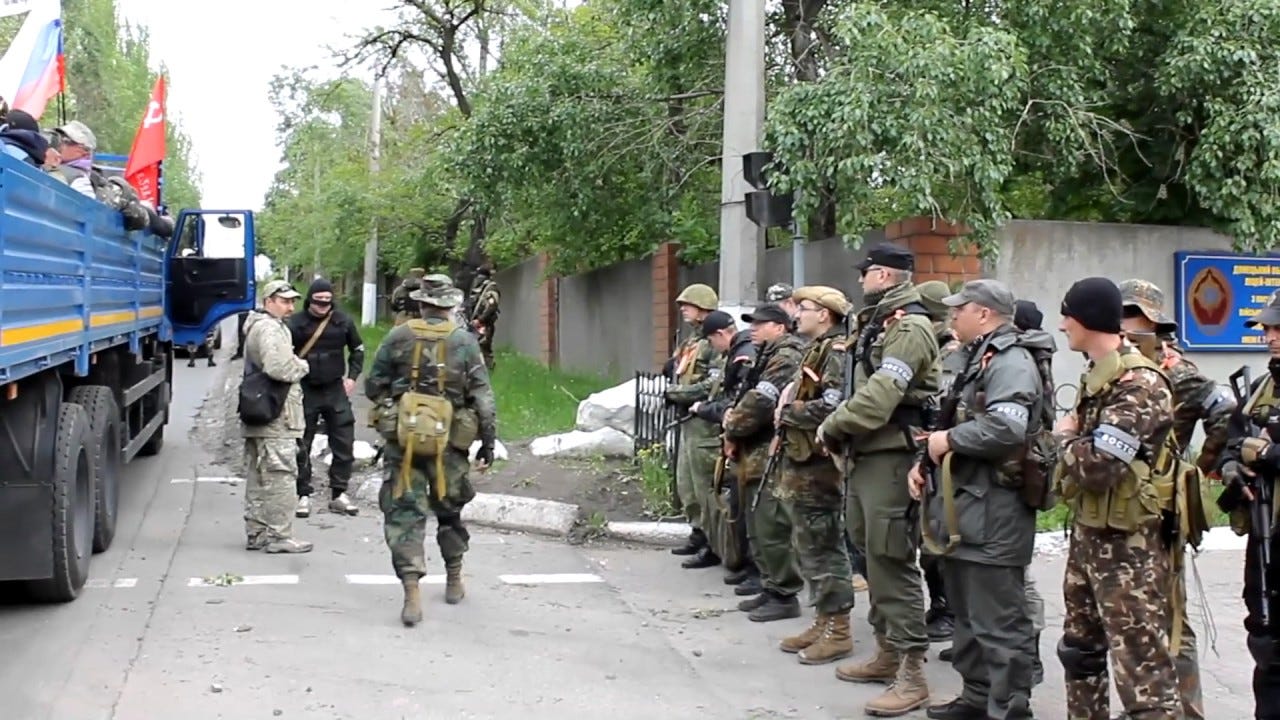
As the assault group approached the checkpoint, they came under heavy fire from multiple directions. The group disembarked at the gas station and took what positions they could. The leading car, a Jeep Cherokee, is shot up and crashes near the station (miraculously, those inside survive). “Felix” recounted:
“We didn’t even get there yet - and immediately came under fire. And my mind drifted to the thought: shooting sounds completely different when you’re in training or at a shooting range. When its coming at you, it sounds evil.
After the group disembarked, I drove to a safe spot so that the car would stay intact, as the other car was left there - it was immediately shot up, destroyed. And when we got the signal that there were the first wounded, I got my minivan there and evacuated them. And like that, I saved 5 people.”
The militants knew that an attack was coming and were prepared to meet it. The reinforcements from Donetsk arrived in the form of a Kamaz with some 80 “Vostok” fighters. What was going to be a raid quickly turned into a fight for survival. One fighter, callsign “Pixel,” was armed only with a camera. It is thanks to him that we have extensive footage of the battle. In the first half-hour, one fighter would already be wounded - Bohdan Ptashnyk, who joined the assault group at the last moment.
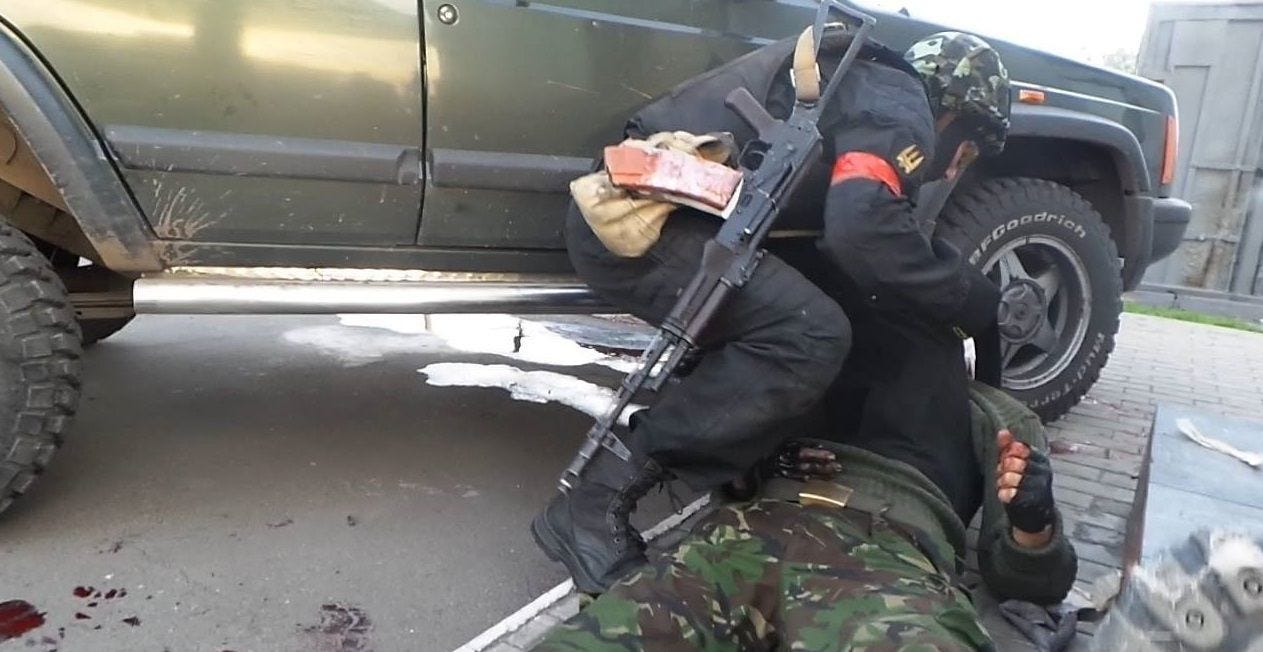
“Heavy fire was coming from both sides. The enemy actively used grenade launchers, their snipers were picking us off.” Next to be wounded was Dmitry “Benya” Babkin, a volunteer from Mariupol, - one bullet grazed his head, while another lodged in his leg.
Another fighter, callsign “Anzhei", was also wounded in the head - the bullet entered just under his right eye and flew out of his ear. The medic “Riaboi,” from Donetsk, rushed to provide first aid under fire.
Soon “Riaboi” himself will be heavily wounded, along with the group’s second medic, callsign “Khorvat.” A VOG grenade exploded near “Khorvat,” breaking his legs. He would refuse medical assistance, laying down with a grenade in his hands.
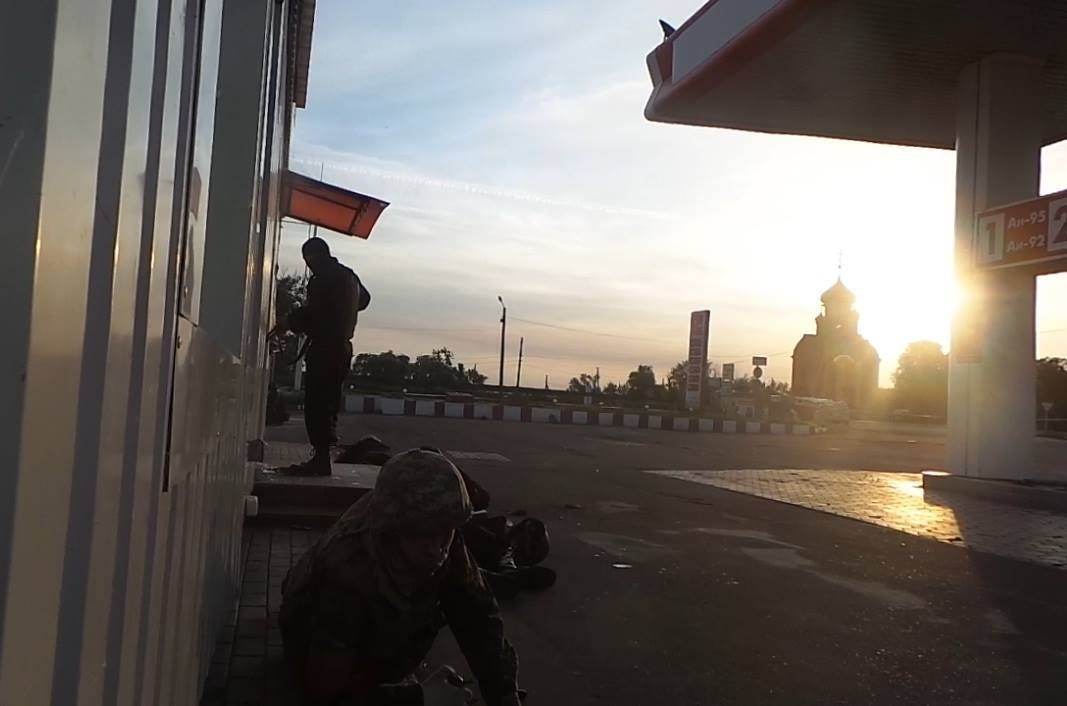
The Battalion’s first death was the assault group’s leader - the 61 year old Nikolai “Matvei” Kozlov.
For some reason, he came to be in a very unfortunate position - at some point he laid down on the asphalt between the gas station and the checkpoint without any cover. Later the fighters reminisced that during the training, which “Matvei” himself conducted, he repeatedly told his trainees that you can’t stay out in the open. And that you can’t fire from only one spot - after every 2-3 shots you have to change position. Why the most experienced and the only battle-hardened officer in the Battalion commited such mistakes is now hard to say.
- Yevhen Shevchenko
One “Vostok” militant described the other side of the battlefield and the militants’ vastly superior weaponry:
“In the morning we were ordered to get up, and we set out for the checkpoint at Karlovka. My group of 6 people was to conduct a reconnaisance-in-force and find out the enemy’s positions. On the approaches to the battlefield, the fire was so intense that you couldn’t even raise your head. In terms of weapons, we had assault rifles, grenades and three grenade launchers. And as a special operations group we had an enhanced ammunition package - 5 magazines and three grenades each. In the early war, such an amount of weapons was a luxury.”
With the mounting casualties, Hrishyn sent out “Felix” with his minivan to evacuate the wounded to Pokrovsk. As the intensity of the firefight was only increasing and their limited ammunition running out, a retreat order was issued - but the only remaining vehicle was the minivan, so the fighters had to hold out until it returned. The group began to retreat from the gas station to take positions in the large “Druzhba” cafe nearby. The sniper “Khimik” laid down in the grass, covering their retreat.
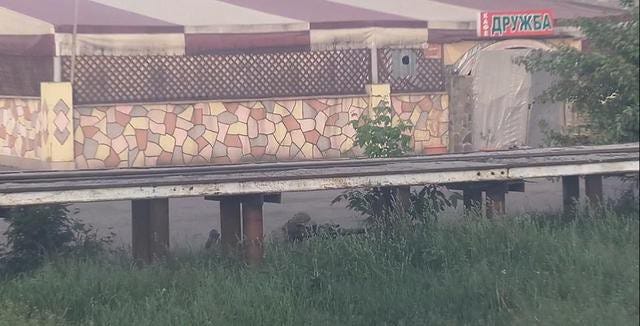
The two fighters who were further up the road, “Serafim” and “Ded”, reported to the Battalion commander that yet more enemy reinforcements were arriving from Donetsk. They were ordered to retreat, but “Ded” was cut off by enemy infantry. After fighting back and running out of ammunition, he laid down clutching a grenade. Vasily “Ded” Arkhipov was a 58 year old miner from Makiivka. Just a few months prior he was a sports trainer. His last words were in a phone call with the others: “The Chechens are coming for me. Over and out.” He blew himself up.
A volunteer associate of the battalion, Natalia Veselova, recounted:
“On May 23rd 2014 I was awoken by a phone call: “a reconnaisance group has been ambushed near Karlivka. We need a BTR to free 6 fighters who have been cut off in a cafe. Call everyone!” - Semenchenko [Hrishyn] was shouting from the phone.”
Veselova and other volunteers called the Interior Minister Arsen Avakov, volunteer-journalists Dmitry Timchuk, Boris Filatov, and Yuri Butusov, the ATO headquarters and others. Hrishyn told Veselova to write on his social media about the ambush to inform the public about the unfolding crisis. By about 10 AM, the still-ongoing battle became a news story. The ATO press service declared that help was coming: BTRs of the 93rd Brigade were nearby at a checkpoint near Pokrovsk.
But for some reason, despite such an order being issued, that help never came. Why remains a mystery, but it is likely due to the demoralization of mobilized officers and soldiers, who weren’t ready to risk their lives. Back in April, a riot broke out in the Brigade’s base in Dnipro Oblast that nearly turned into a full-scale mutiny.
A “Donbas” fighter initially uninvolved in the raid, callsign “Hammer,” rushed to the scene in his car. The remnants of the assault group rushed to evacuate as 4 fighters remained in the “Druzhba” cafe to cover their retreat. They planned to wait for the return of “Felix’s” minivan and the anticipated reinforcements from the 93rd Brigade.
Our army’s closest checkpoint was just 5km away from Karlivka - these were the 93rd Brigade’s positions, well-armed and most importantly possessing three BTRs. But unfortunately, nobody came to help the “Donbasites.” As we later learned, at 9:00 their commander received an order to move out to Karlivka to help the surrounded volunteers, but due to unknown reasons the officer refused to obey this order - leaving the surrounded volunteers to die…
- Yevhen Shevchenko
The 4-man rearguard consisting of “Raider,” “Khimik,” “Almaz” and “Fiedor” were surrounded in the cafe and fighting with their last ammunition as, in a dark twist of irony, a BTR-70 came to aid the enemy. The cafe building was under fire from assault rifles, machineguns, and grenade launchers. Oleh “Raider” Kovalishyn, the programmer and Wikipedia contributor from Bakhmut, was heavily wounded and bleeding out. He told “Khimik” and “Almaz” to leave him. An RPG rocket hit the building, causing it to catch fire.
Around this time Alexei “Fiedor” Miroshnychenko was shot dead by the enemy. His body would later be mutilated - the militants would cut his heart out, and he would be tied to the back of a “Vostok” truck and dragged that way back to Donetsk.
A “Vostok” militant would describe the desperate fighting that took place around the cafe:
“In the end we forced the Ukrops into a cafe near the checkpoint. The cafe had a basement where they took positions, and we would try to smoke them out with grenades. I gave an order to keep an eye out for the doors and windows. By this time “Vzhyk” and “Obraz” were killed. “Vzhyk” was shot right in the face from a window. This is how they fought - running out of the basement, throwing grenades, taking potshots and ducking back in.
The pitch-black smoke rising from the building caused the militants to back off. As the smoke engulfed the cafe, “Almaz” and “Khimik,” both wounded, navigated their way to the back entrance and escaped. “Almaz” hid in the greenery surrounding the reservoir, while “Khimik” laid down under a piece of metal debris. They were hiding until it was safe enough to pick them up the next morning.
“Riaboi,” the medic from Donetsk who was wounded early in the battle, would die in a Pokrovsk hospital from his wounds.
V. Aftermath
The loss of their comrades was a heavy blow to the “Donbas” volunteers. None of them were psychologically ready for the death of their brothers-in-arms, especially after such a wave of successes.
- Yevhen Shevchenko
25 of the Battalion’s 60 fighters were killed or wounded. Casualties on the Russian side are disputed - “Vostok” confirmed 6 killed, but some report that Donetsk morgues received 15 corpses that day.
The news of the tragedy were spread wide on social media and television. It led to a certain amount of outrage. But its also after this battle that the Interior Minister Arsen Avakov officially contacted the Battalion’s leadership and offered to integrate them into the National Guard, where they would receive all the equipment and training they’d need. “Donbas” left the frontline for Dnipro Oblast as the number of volunteers to what was now called the “2nd “Donbas” Special Purpose Battalion of the National Guard” surged, and soon hundreds of new fighters were in training.
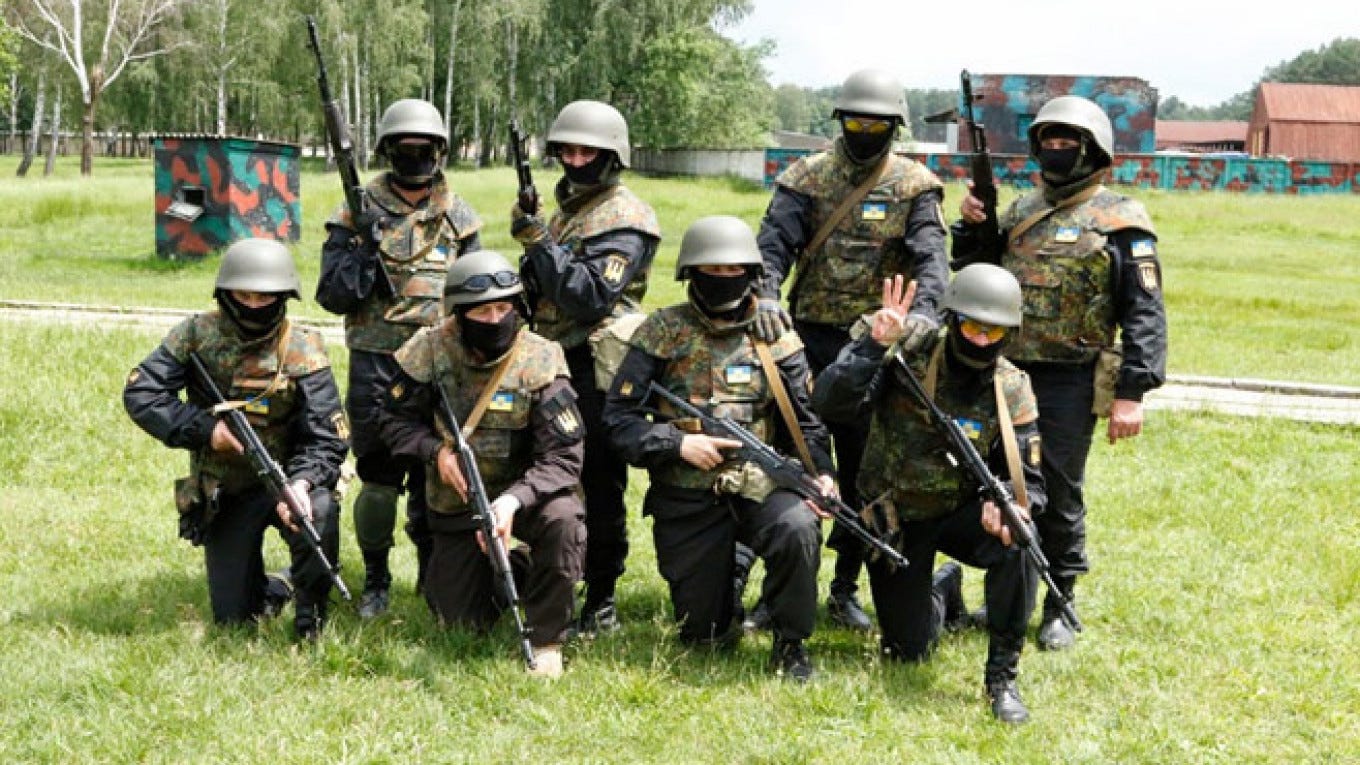
The fighting for Karlivka would continue until June 10th, when the fighters of the 93rd Brigade, “Donbas,” “Dnipro,” and “Right Sector” together pushed “Vostok” out of the village, opening the road to Donetsk.
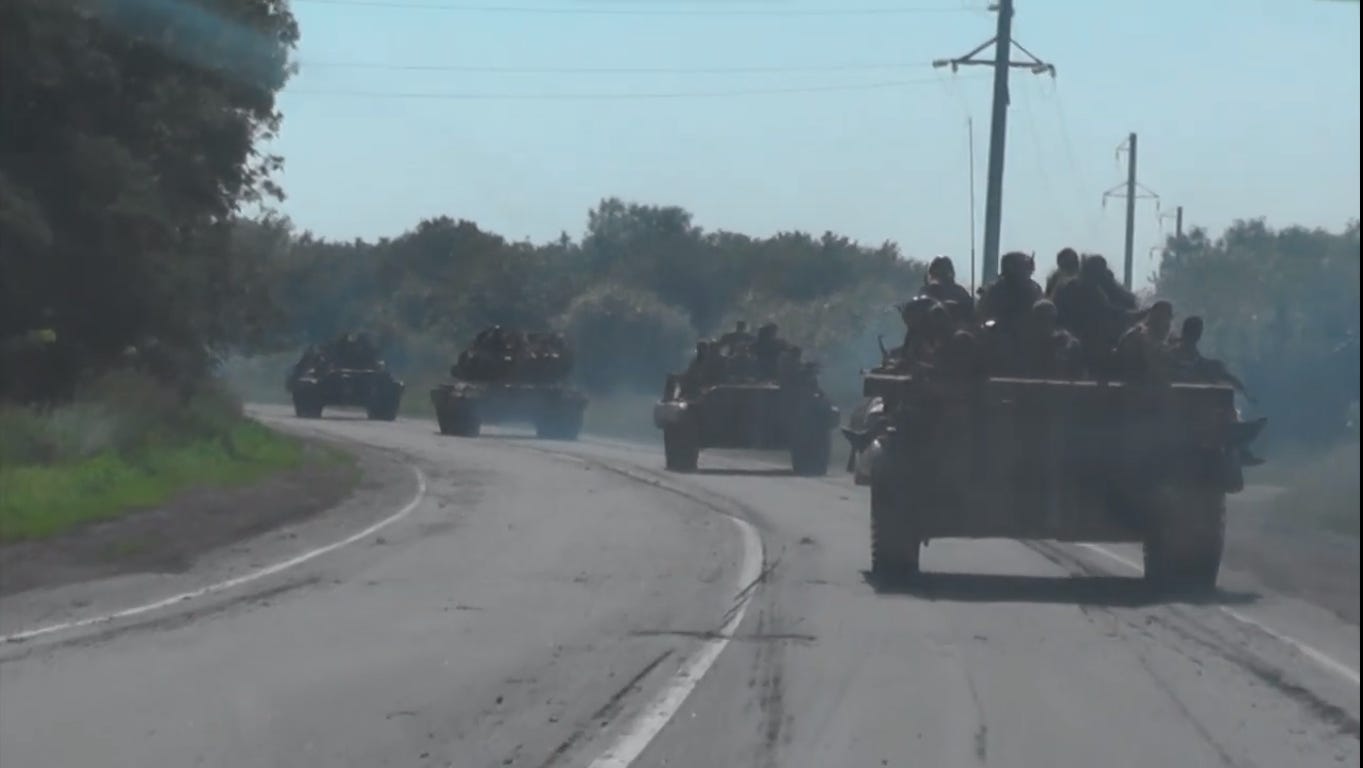
The footage recorded by the assault group’s cameraman, “Pixel,” would be edited and posted to YouTube where it garnered a lot of attention at the time. I subtitled the video and put it up on my YT channel:
Thank you for reading! As far as I know, this is the most extensive English-language article on the first battle for Karlivka, its’ context and lead-up, despite this battle’s crucial importance to the course of the ATO.
If you appreciate my work of shedding light on the obscure, forgotten, but important events from the early war, please consider donating on my BuyMeACoffee as finding the material, researching, writing and subtitling all takes a very considerable amount of time. If you don’t follow me on social media, make sure to check out my Twitter and BlueSky profiles.
Eternal glory to the defenders of Ukraine.





